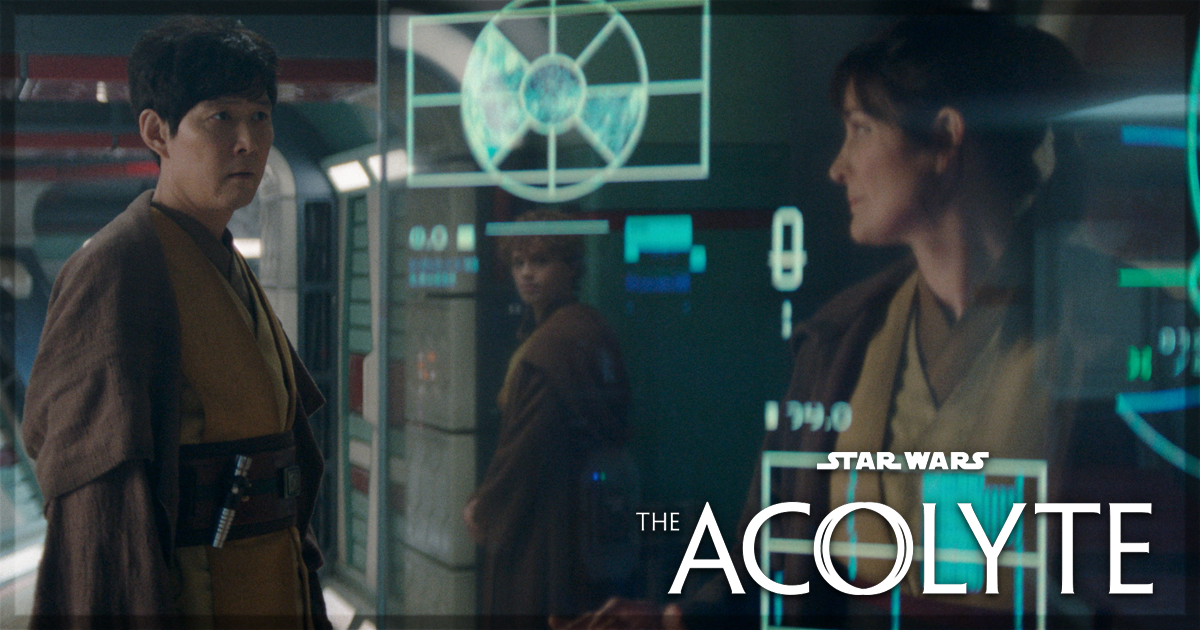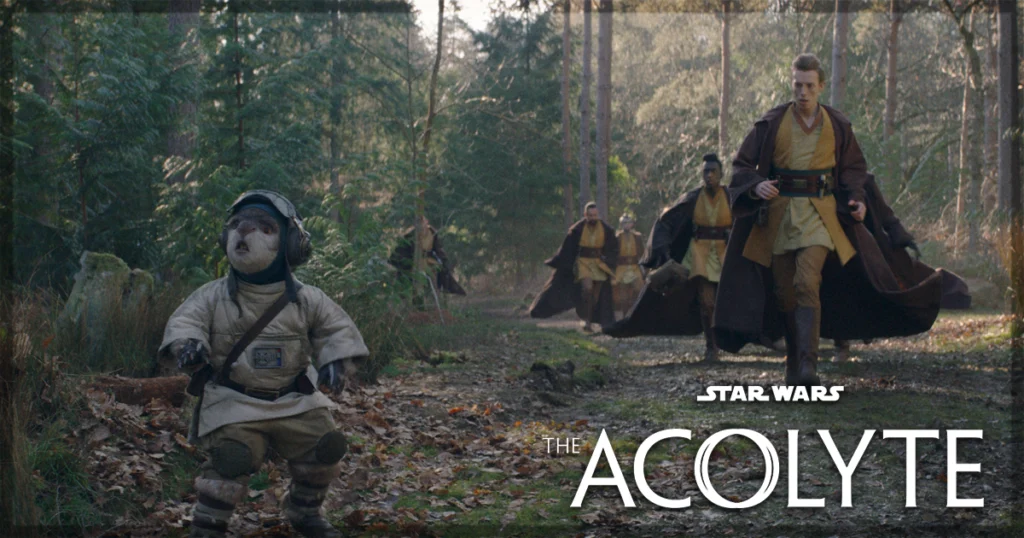The Acolyte takes us on a role reversal of an episode in Teach/Corrupt as it embraces Osha and Mae’s switch in personality and character. Mae is now with Sol; grieving for the loss of his team at the hands of the Sith, and his Padawan Jecki who got slaughtered in a bloodbath of an episode that preceded this one. It’s tough, ruthless and hard for anyone who can come to terms with it least of all Sol; who has demons over his past. It’ll be interesting to see what happens when they come to light as he’s had multiple years to ponder what to say to Mae.
But he doesn’t quite know yet. With Mae and Osha looking almost identical it’s easy for Mae to convince Sol that she’s the other twin; and Sol buys it, wanting it to be true. The others on the ship are not easily convinced – and soon, her ruse is uncovered. Not before Mae switches out Pip to factory settings, taking it away from her sister too. The Acolyte has been determined to play with balance and based on this episode it looked like for a while that Mae’s path to redemption was clear – but are they going to allow her that? Sol seems like he’s willing to come clean about his part in the whole incident that hangs over both siblings like a heavy shadow – but will Mae accept it? There’s truth and there’s consequences. Early predictions for me have Mae and Osha joining forces under the Sith to kill their mentor; leaving the Jedi – and becoming the Rule of Two; but it feels like this show could go anywhere this late in the game.
One of the main “criticisms” of The Acolyte, if you could call it a criticism, is that the show has portrayed the Jedi as being too stupid. How could they let a Sith go right under their nose? How could they search for rational explanations that would lead them to believe that Sol had turned? Harry Trevaldwin brings a type of aloofness to his role of the Jedi that has him turn into a hateable character almost instantly – how dare he come to the conclusion that Sol had fallen, you want to ask, everything he had been through? The failure to even entertain the concept of the Sith suggests how easy it was for Palpatine to infiltrate the Council. They’re not actively looking – they’re unwilling to embrace the idea at all. The idea that a Jedi could fall is beyond them. This is the idea that made the prequels’ themes work and the idea of corruption of a republic could lead to its downfall; there’s a reason why it happened, and The Acolyte exists to show the flaws in the Jedi weren’t just a recent thing – they were there from day one.
Osha is embracing them too. She’s been kidnapped; but left with a weapon – the Sith are pulling the whole “if you strike me down, you will become me”, trick, and for Osha it’s working. Did she really leave the Jedi out of choice? Or was she rejected by them? Her stance when wielding Qimir’s lightsaber is experienced, and Qimir recognises that. Manny Jacinto plays the cocky, confident but also deeply hurt Sith Lord with scars against his past determined to show that there’s another way out there – he’s longing for the rule of two; the rule that the Sith have embraced for millennia – but with Mae betraying him, he’s turned his attention to Osha. And Osha is listening. The helmet he wears exists to make him one with the force is given to her as a gift, as a temptation. And she eventually caves – the fall; the anger – it’s been coming. Osha is The Acolyte – not Mae. She’s the one who left the Jedi and her path is as every bit as daring as Qimir’s – lured under his spell. Qimir’s argument for the justification for killing everyone who came up against his warped but he also has a point, every relationship that Osha has had has been entirely one-sided. First Sol, the father, then Jeckie – the friend – she knows Jedi rules will never let them become anything more.
We’re seeing a tradition rip the Jedi order apart at its core. The whole conversation of Qimir and Osha echoes Luke, Kylo and Rey’s in The Last Jedi, a film this show seems massively influenced by, especially in the portrayal of the island where Qimir calls his home. He tells Osha he can leave, he argues that she’s not in captivity when she has the weapon, and he even points out the absurdity in not killing him at the heat of the battle but killing him when he’s alone and unarmed feels almost wrong. There’s still an element in honour, even after she’s just witnessed him kill all that Jedi. The same honour, the guilt that tears at Sol – leaving with a lingering thread that nobody is safe from the allure of the dark side as we approach the latter stages of The Acolyte, which will end one way or another with someone falling. This show has given us the idea that nobody is safe, and Osha – not Mae turning may upend the scales of it all.
The Acolyte – Episode 7 – Choice – Review
Choice takes The Acolyte back to where it began with another perspective; the true, Rashomon-esque perspective that The Acolyte has been drawing influence all along. Here we get to see, removed from Osha’s events, the true version of what unfollowed on Brendok from the Jedi’s perspective. It’s the fate of the series unfolding in its hand; the penultimate episode where a house of cards come crashing down. Why would the Jedi enable a cover up – and what guilt could a Jedi have from it that it would lead to one’s own suicide? The penultimate episode is where the reveals all come pouring out.
Sol and Indara did not come to Brendok with a sinister purpose and were not quite as evil as the Sith paint them out to be. Their intentions were noble; initially, with Kogonada stepping back into the directors’ chair to essentially repurpose a lot of already used shots in one smart way of working within the limitations of the series’ budget. It’s kind of similar to a clip show episode but gets away with it by spinning differently, because after all, who has time for a clip show episode in a seven episode series?
Sol has an obsessive complex that gets into his mind, and we saw that in the past with him mistaking Mae for Osha, not ready to accept it. He’s a flawed persona and he got in his mind that he was rescuing the girls from their captivity – he used the force to only hold up Osha, not Mae – sending her to her would-be death. It’s a pretty heavy blow for anyone to make and Sol only having enough energy to save one understandably, leaves a heady shadow on the broken bridge. Indara was initially not trying to intervene, there were noble intentions there – and I really enjoyed learning the Jedi’s intentions here and why they set about doing what they did. It’s easy to see why it was kept hidden early on; the first flashback is deliberately vague, deliberately not quite there.
Torbin was corrupted early on and it’s clear that he’s not the smartest Jedi in the world but then the whole theme of this show and the prequels is that they’re not the smartest organisation that everyone believes them to be. The rarity of the Vergence in the force brings up multiple questions but Torbin aiding Sol shows his homesickness, and he almost feels like a proto Yord but without the cocky aloofness. It’s very easy to see his role as a flawed padawan still learning the ropes, but you think when your role is a Jedi who will go out across the stars, you might be willing to accept home a little more easily? I did appreciate how easily Aniseya manipulated him showing her power to the audience with instant; eerie effect. Manipulation has been a touchstone of the series in its corruption of its characters; first Mae, then Osha, now Torbin – and I did like that it was setting him down an interesting path.
If there was a weak link that The Acolyte failed to effectively deliver in this episode was how anticlimactic it all felt. The death of the witches felt so quick it was flawed – when their connection to Kelnacca broke, their corpses being shown really left an underwhelming taste. I was expecting something almost more – but more was what we got elsewhere, the show laying the groundwork for The Phantom Menace and the concept of a Vergence in the Force builds on the term superbly well. We see the shadow of Anakin Skywalker everywhere over this series, there was a reason why actress Amandla Stenberg cited the prequels as her favourite Star Wars films, especially Revenge of the Sith. She’s got taste!
It’s just hard to imagine everything wrapping up in next week’s finale short of a second series that Disney+ haven’t explicitly renewed yet. There’s surely no way we can get a satisfying conclusion with all these loose threads left unraveled. The best part of this episode was reminding us of the Jedi mindset – and of course, Kelnacca wielding a lightsaber. A wookie Jedi is such a cool concept you’re surely kicking Lucas for not showing one in the main series, and Star Wars as a whole for not bringing one in earlier – and seeing him in combat was so cool. As a counterbalance to that, the way they died was rather weak – possessing a Jedi rather than Mae’s fire, rendering Mae innocent, and destroying their home without killing anyone. Sol killing Aniseya was the big character moment here – and it makes him so much more interesting. That said – I don’t think Kogonada feels at home in the Star Wars universe although that shouldn’t discourage you from watching AppleTV+’s excellent Pachinko, After Yang or Columbus. He needs a feature to let him breathe.
And we have a pop song in Star Wars. Repeat, we have a pop song in Star Wars! Victoria Monet’s Power of Two feels as fitting a song as ever.


